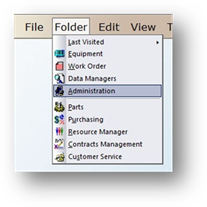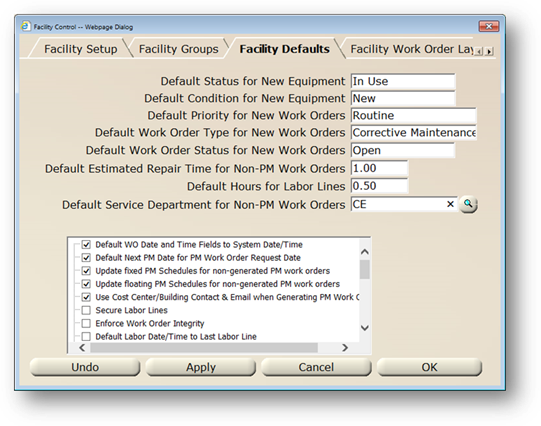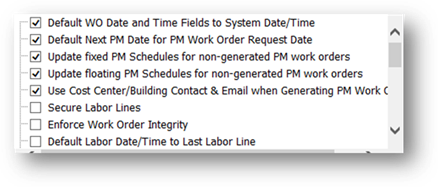
In multi-facility systems, you can set some defaults and behaviors separately from one facility to the next. Options that are grayed out must be set in the System Defaults tab of the Administration control.
1. Open the Administration Control by clicking on the toolbar Administration button or use the menu Folder > Administration.

2. Click on the Multi Facility Tab.
NOTE: This will only be available for CCS customers. Core users should use the Single Facility Defaults.
3. Select a Facility in the valid entry list and click Edit.
4. Click on the Facility Defaults Tab.
Facility Defaults

1. Default Status for New Equipment – Select the status that will automatically display for equipment.
2. Default Condition for New Equipment – Select the condition that will automatically display for new equipment.
3. Default Priority for New Work Orders – Select the priority that will automatically display on newly created work orders. This only applies to corrective maintenance work orders, not preventive maintenance.
4. Default Work Order Type for New Work Orders – Select the value that will automatically display as the work order type on new corrective maintenance work orders.
5. Default Work Order Status for New Work Orders – Select the value that will automatically display as the work order type on new corrective maintenance work orders.
6. Default Estimated Repair Time for Non-PM Work Orders - Enter the default setting for all new Non-PM work orders or 0.00 if there is no setting.
7. Default Hours for Labor Lines – Enter the default hours for all work order time lines. This will be the value that is displayed when applying time to work orders.
8. Default Service Department for Non-PM Work Orders – Select the service department that will automatically display on new corrective maintenance work orders.
Check Boxes

9. Default WO Date and Time Fields to System Date/Time - If checked, date/time fields default to the system date/time.
10. Default Next PM Date for PM Work Order Request Date - If checked, this will set the work order request date to the date on the PM Schedule for the tag used on the work order. Otherwise, the current system date will be used.
NOTE: This generates work orders prior to the next PM scheduled date while maintaining the PM schedule date for PM programs and PM work order reports.
Example: The next PM schedule date of 04/01/xx will have a request date of 04/01/xx even if generated on 03/28/xx.
NOTE: You can filter by request date when running work order reports.
11. Update Fixed PM Schedules for Non-Generated PM Work Orders – When checked, AIMS will update the Next Date on a PM Schedule when you manually create a PM work order for a certain tag and use the procedure associated with that tag’s PM Schedule. Otherwise, only PMs created during the PM Generation function will be updated.
12. Update Floating PM Schedules for Non-Generated PM Work Orders – When checked, AIMS will update the Next Date on a PM Schedule when you manually create a PM work order for a certain tag and use the procedure associated with that tag’s PM Schedule that is also configured as a “Floating PM”. Otherwise, only PMs created during the PM Generation function will be updated.
13. Use Cost Center/Building Contact & Email when Generating PM Work Orders – When checked, AIMS will use the Cost Center/Building main contact as the Requester when PMs are generated. If no such contact exists in Cost Center/Building, Scheduled PM will be used.
14. Secure Labor Lines - If checked, only the person who applied time can edit their own entry. Security Level “A” does not override this setting.
15. Enforce Work Order Integrity – Checking this option will cause AIMS to check certain criteria such as:
⋅ Cannot save a Labor Line if the Date/Time of the first time line is after the Date/Time of the Line Item being entered.
⋅ Work Order Close Date/Time must be the same as the Last Timeline Date/Time.
NOTE: It is recommended that you activate the option to Default close date based on last time line.
⋅ Labor Line entry cannot be entered with a date/time that is before the Work Order Request Date/Time.
⋅ Total Time Applied to Work Order cannot exceed the Total Time Available for that Work Order.
Example, the first timeline is at 1pm and the last timeline is at 3pm; there cannot be more than 2 total hours applied to timelines for any one employee.
⋅ Work Order Request Date/Time cannot be in the future.
⋅ Work Order Close Date cannot be in the future. It is recommended that you activate the system option Do Not Allow Close Dates in the Future.
16. Default Labor Date/Time to Last Labor Line – If checked, the date/time on timelines will be the date/time of the last time line. Otherwise it will default to the current system date/time
17. Default Close Date Based on Last Labor Line - If checked, the work order close date defaults to the date entered for the last applied time entry on the work order. If unchecked, the system date at the time the work order was closed is used.
18. Do Not Allow Close Dates in the Future - If checked, does not allow use of a future close date.
19. Close Re-Opened Work Orders with Original Close Date - If checked, a re-opened work order will reflect the original close date when closed.
20. Limit Available Responses Based on Work Order Type – If checked, the response drop-down list in the Work Order Update tab will display only work order Type related codes. This is a Global setting and cannot be changed here.|
21. Do Not allow Part Inventories to Go Negative – If checked, AIMS will not allow users to enter part quantities which cause inventory levels to go below zero.
22. Track Part Kit Inventory – Check this if you group parts into kits for PM work orders. AIMS will allow you to apply entire kits to work orders rather than individual parts.
23. Require Labor Line with PM Response Before Closing PM Work Orders – Check this option to require a PM labor line on PM work orders before closing the work order. Otherwise, work orders may be closed without any labor applied.
24. Require Labor Line Before Closing Non-PM Work Orders – Check this option to require a labor line on Non-PM (corrective maintenance) work orders. Otherwise, work orders may be closed without any labor applied.
25. User Warehouse Filtering – Check this option to filter access to part warehouses based on logon. If checked, a user must be assigned to a warehouse in order to access parts from that warehouse.
26. Customer Signoff on Work Orders – Check this option to activate the work order signoff function. Additional setup is necessary in the Account setup in order to take advantage of this option.
27. Open Default WO When PM is “Passed With an Issue” – Check this option to have AIMS automatically open a corrective maintenance work order when a PM work order is closed with a response configured as PM Passed with an Issue. The work orders will also automatically be grouped as parent/child in Work Order Grouping.
NOTE: AIMS will only evaluate the last timeline if more than one PM Response is applied.
28. Use Shift Settings for Work Order Assignment – Check this option to use the Shift Settings in Resource Manager when employees are assigned to work orders.
29. Show Coded Problem – Check this option to make the work order problem field populate from a pre-defined list of problems.
30. Force MAC address to be unique – Check this option to receive a warning when adding a MAC Address if a duplicate MAC Address already exists in the facility.
31. Force Windows Authentication – Check this option to use Windows Authentication.
32. Facility Specific Required Fields – If checked, required fields will not be Global across all facilities, allowing each facility to specify which fields should be required.
NOTE: This is an irreversible process.
33. Default Work Order Labor Lines as Billable – Check this box to set the default of the billable checkbox on work order labor lines to Yes.
34. Default Work Order Material lines as Billable – Check this box to set the default of the billable checkbox on work order material lines to Yes.
35. When setup is complete, click OK to return to the Administration control.